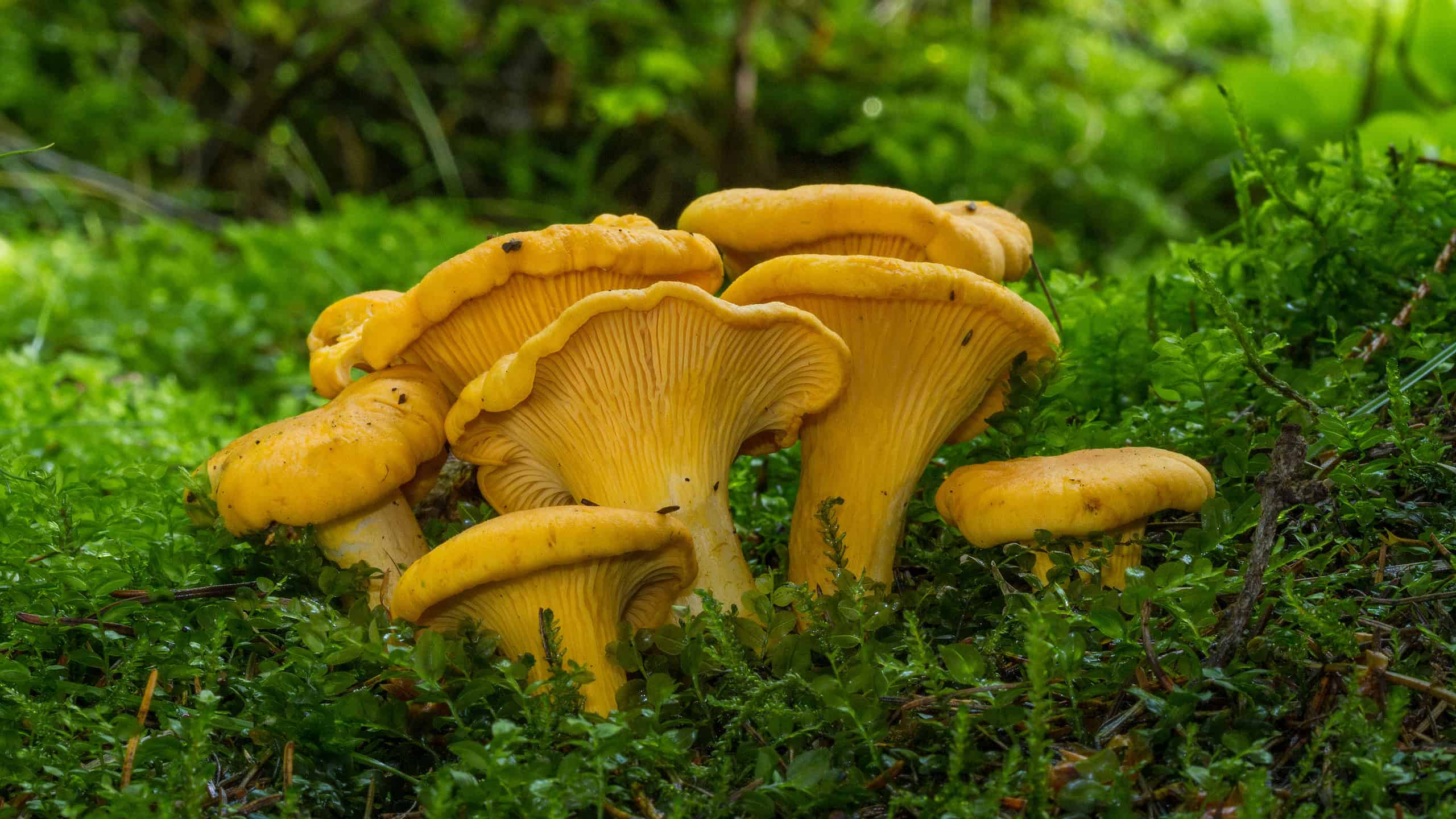Imagine walking through the forest, the fresh air carrying a scent of humus in the air, and seeing brightly colored mushrooms. What are they? Are they edible? The excitement of finding edible mushrooms for the first time is intangible, and that feeling is often in hopes of having found the classic chanterelle.
One of the world’s most beloved edible mushrooms, there are over 50 species of chanterelle mushrooms recorded worldwide. Their exquisite fruity aroma and flavor will certainly tantalize anyone’s tastebuds.
This list will be limited to some popular species of edible chanterelles found in North America rather than how to identify them. Furthermore, recipes and culinary ideas will be included for you to explore.
What is a Chanterelle?
Chanterelle is a common name for any mushroom belonging to the family Cantharellaceae, all of which are recorded as edible. There are, however, toxic look-alikes such as the False Chanterelle, the Jack-O-Lantern mushroom, and the Wooly or False Scaly Chanterelle. They all are mycorrhizal mushrooms, thus they form symbiotic relationships with the roots of specific trees. Unfortunately, they cannot be cultivated.
Kingdom: Fungi
Phyllum: Basidiomycota
Class: Agaricomycetes
Order: Cantharellales
Family: Cantharellaceae
Types of Chanterelle Species:
Cantharellus enelensis
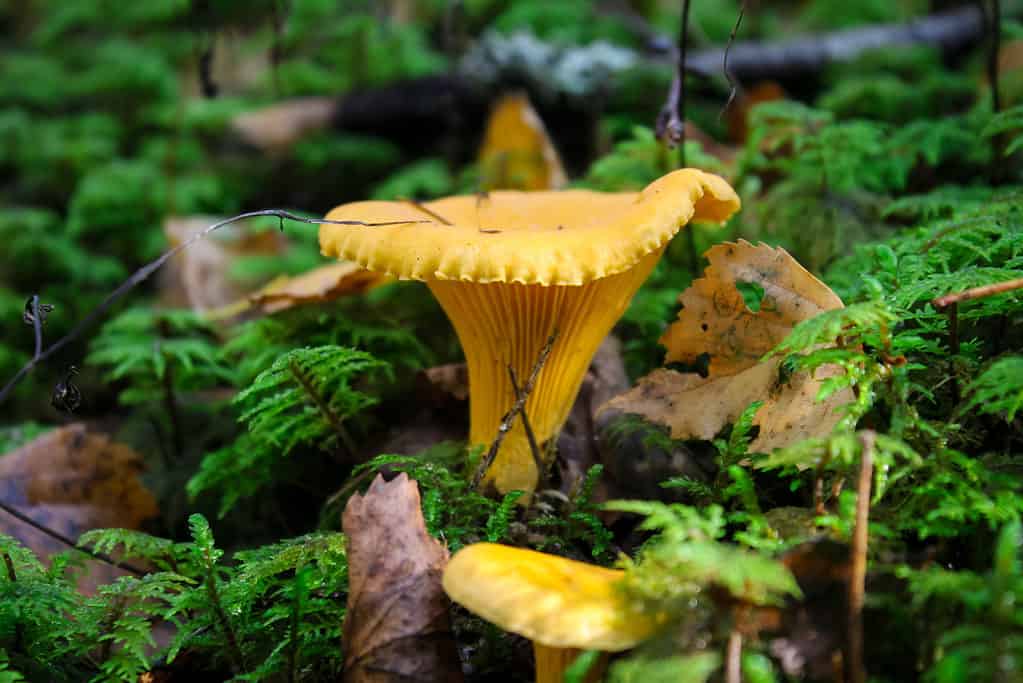
A classic Golden Chanterelle.
©iStock.com/Krot44
Cantharellus enelensis is the official name for the “Golden Chanterelle”, or “Griole” in French, in eastern North America. Formerly called C. cibarius, which is exclusively European, this is just as meaty, fruity, and fragrant. People are known to geek out in complete delight upon discovering this. The bright orange pops out amongst the brown forest floor. The scent is close to that of apricots, and the two can certainly be combined. Another simple yet fantastic way to enjoy the “Golden Chanterelle” is to sautee in butter until brown and finish with a brandy flambe. This is quite astounding as the brandy complements the delicate apricot aroma.
Cantharellus cinnabarinus

Cantharellus cinnabarinus popping brightly from the forest floor.
©K Quinn Ferris/Shutterstock.com
Also known as the “Cinnabar Chanterelle”, Cantharellus cinnabarinus is quite the “hoot” to find. As in, the excitement of finding this small reddish-orange gem along a dirt trail may very well bring forth a whoop of elation. The astounding flavor is considered to be more pronounced than that of the “Golden Chanterelle”. It is quite small in comparison, however, it can grow in patches for a decent personal harvest.
Cantharellus lateritius
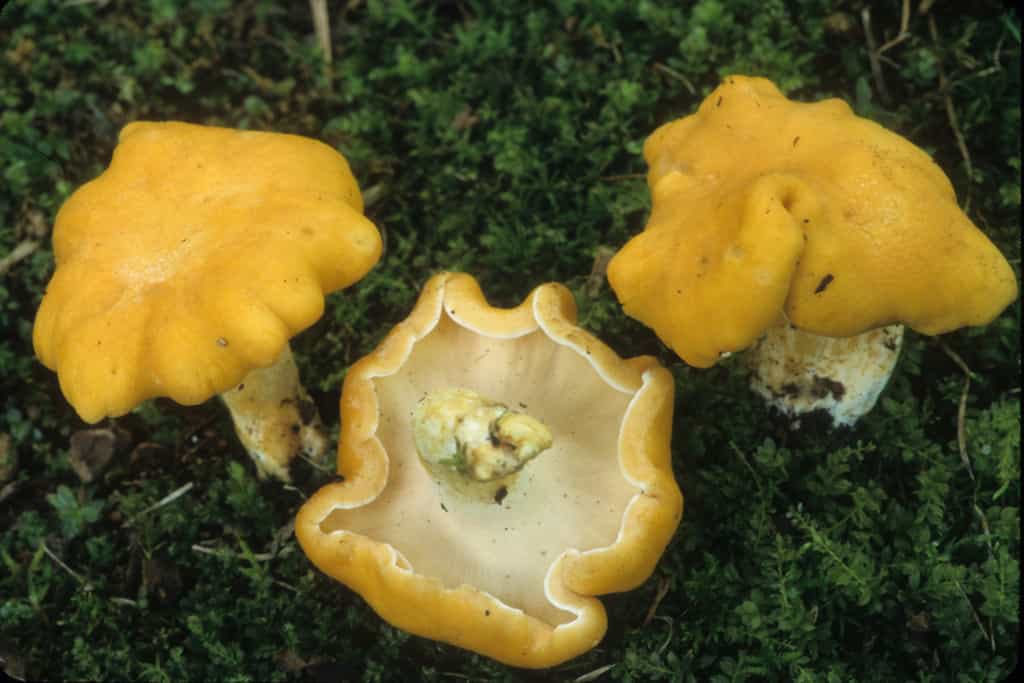
This an amazing example of the smooth fertile surface of the “Smooth Chanterelle”, in contrast to the blunt gills of the “Golden Chanterelle”.
©John Plischke aka johnplischke / CC BY-NC 4.0 https://creativecommons.org/licenses/by-nc/4.0/ https://www.inaturalist.org/observations/153142820 – Original
Here’s a chanterelle that will cause a double-take view. It looks like the “Golden Chanterelle” from above, but it has a completely smooth hymenial, or spore-bearing surface. Having no gill structure whatsoever, it has naturally earned the common name the “Smooth Chanterelle”. The lack of gills certainly makes this not-so-common species very easy to identify. Like all Chanterelles, patches of this mushroom are perennial, thus keep an eye out each year.
Craterellus fallax

A cluster of Black Trumpets growing in moss.
©SariMe/Shutterstock.com
Craterellus fallax, or the “Black Trumpet”, has got to be one of the most difficult mushrooms to find, simply due to its dark hue. Delicious by itself, as a pizza topping, in an omelet, or even atop a juicy steak, this is an incredibly savorous mushroom. A truly delectable earthen treat, it is adored for its fruity fragrance, and both the taste and texture hold up very well when dried and reconstituted. This mushroom can be sauteed in butter or oil to eat alone, enjoyed with any egg recipe, and can be added to any stew, sauce, or slow-cooker meal. In other words, it is not only amazing to eat, but incredibly versatile for any level of chef. Some creative folk had the idea of infusing a few in vodka for an interesting cordial. The recipe is included below.
Craterellus tubaeformis
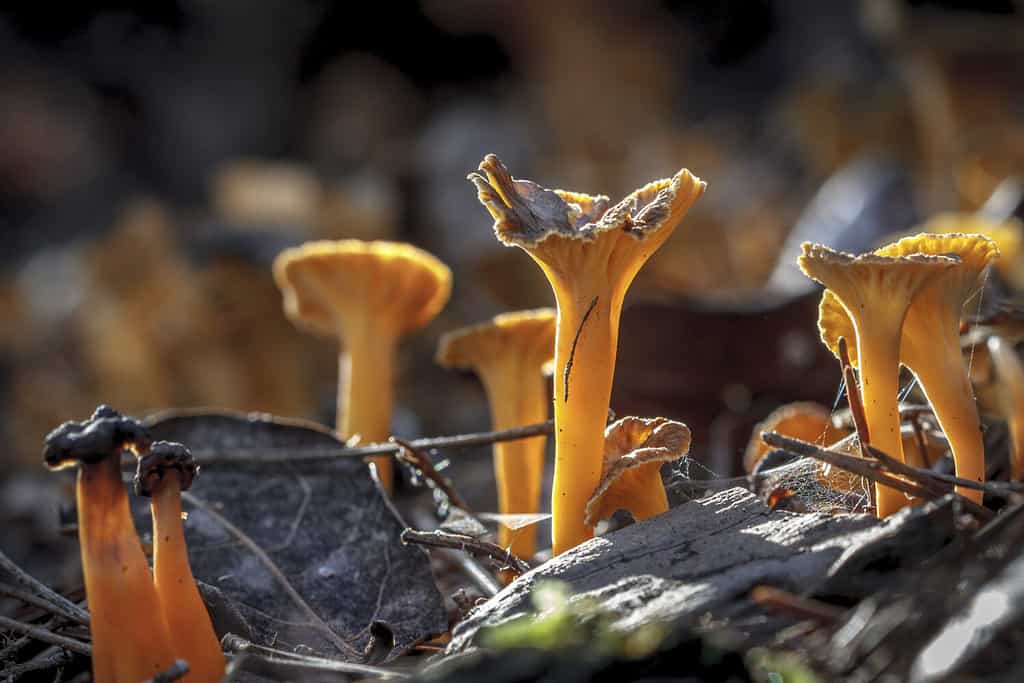
©Gonzalo Jara/Shutterstock.com
The “Yellow Foot Chanterelle” can grow in patches of large numbers.
Craterellus tubaeformis holds at least three common names in English, such as the “Yellow Foot Chanterelle”, the “Winter Chanterelle”, and the “Funnel Chanterelle”. This small, thin mushroom has a brown cap, yellow stem, and greyish false gills, like the “Golden Chanterelle”. It has a more woodsy than fruity aroma, and it can grown in enormous patches. It tends to grow later in the season and loves to grow amongst moss in conifer forests.
Craterellus odoratus

An enormous cluster of the “Fragrant Chanterelle”.
©MIROFOSS/Shutterstock.com
This mushroom grows as an astounding cluster of smooth orange beauty. Found primarily in the southern Appalachian Mountains, this is similar to the “Smooth Chanterelle” yet grows in large clusters. Highly regarded as a wild edible, the “Fragrant Chanterelle” is named for its amazing fragrance.
Cantharellus subalbidus
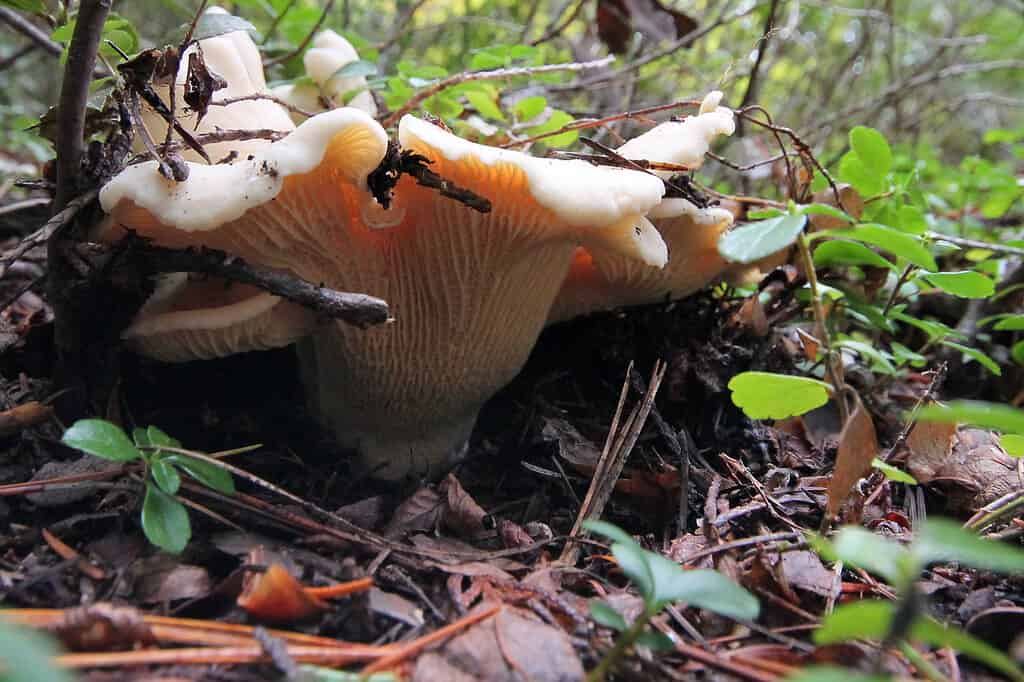
Native to the West Coast, the “White Chanterelle” grows late into the season.
©iStock.com/randimal
The “White Chanterelle” is a choice edible that hails from the Pacific Northwest and California. This is a rather large chanterelle, having stems up to an inch thick, and two inches long, with caps 2-4 inches wide. Fruiting in fall to winter, it is gregarious in mixed forests but loves Douglas Fir and Madrone.
Craterellus ignicolor

This picture of
Craterellus ignicolorshows its similarity to the “Yellow Foot Chanterelle”.
©Stuart Tingley aka stubirdnb / https://creativecommons.org/licenses/by-nc/4.0/ https://inaturalist.ca/photos/171912291 – Original / License
Somewhere between the “Golden Chanterelle” and the “Black Trumpet” comes Craterellus ignicolor. This is rather thin and small, as the stems are only 3/4- 2 inches tall. Likewise, the cap can be 1/2- 2 inches wide, and this vase-like chanterelle has a hollow stem. The cap is bright orange to orangish yellow, and underneath one can find greyish-yellow blunt false gills. You may find patches of this mushroom in mixed forests which include birch, beech, and oaks around areas with spagnum moss.
Cantharellus minor
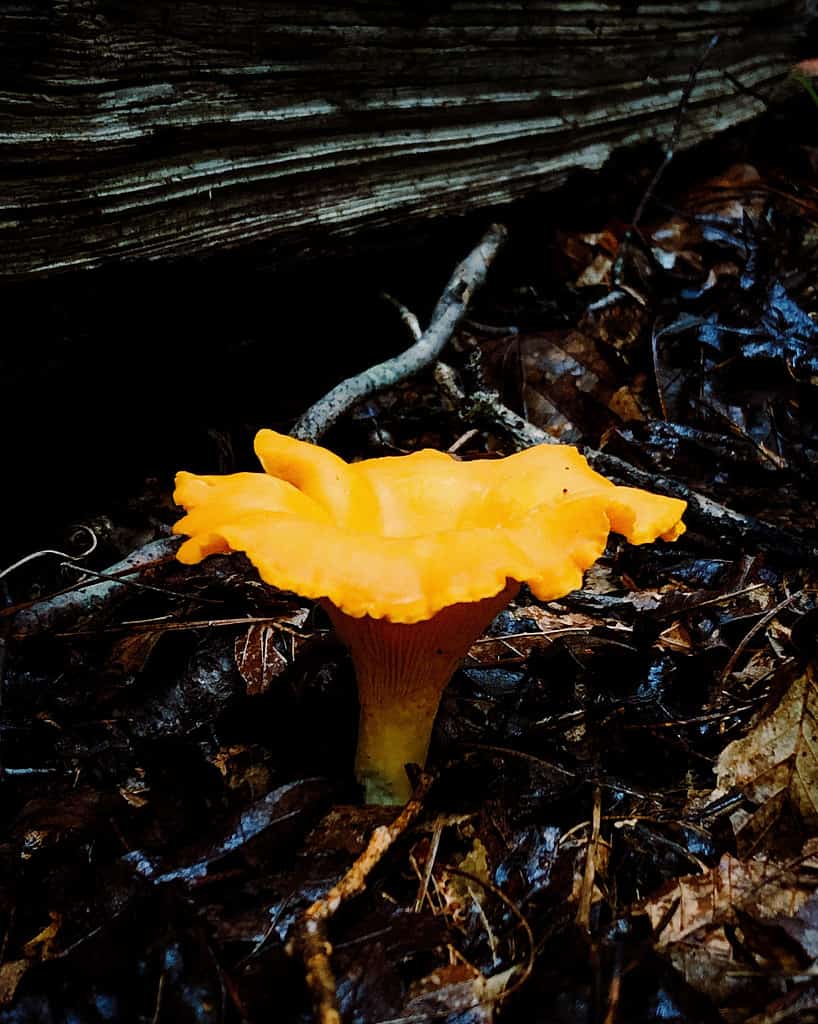
The bright orange
Cantharellus minoris small, yet very visible on the forest floor.
©iStock.com/Wirestock
Last in this incomplete list of edible Chanterelles is the “Small Chanterelle”, which is tiny and insubstantial individually. This also resembles a mix of “Black Tumpets” and “Golden Chanterelles”, as it is more funnel-shaped, has ridged gills, and a slender hollow stem. Despite its size, it certainly adds vibrant color to any wild mushroom sautee.
Conclusion
In conclusion, all species of the Chanterelle family are considered edible. Although, specifically for the “Golden Chanterelle”, there could be toxic look-alikes. Be sure to at least familiarize yourself with the “Jack-O-Lantern” mushroom, which grows in clusters fused at the base. Never eat any wild mushroom unless you are 100% positive of its identification.
How to Cook and Enjoy Chanterelles
First off, all wild mushrooms should always be eaten having been cooked for at least 7-8 minutes over medium heat. Most mycophagists agree that “butter makes it better”, however, any cooking oil will suffice. Many also prefer to brown the mushrooms slowly. Afterward, the world is your oyster, and the culinary creations are endless. While scrambled eggs can be a popular way to try them, there are even people who have made “Golden Chanterelle” ice cream! Thus, be your creative chef.
Recipes and Preservation
Unfortunately, the “Golden Chanterelle” does not hold up well being dried. Not only does it lose its fruity aroma, but it also becomes rubbery when rehydrated. Conversely, “Black Trumpets” are an exceptional dried mushroom and will last indefinitely when stored air-tight. When adding any mushroom to an omelet or pizza, it is always best to sautee it first to your liking. A popular basic method to preserve any wild mushroom is to make Duxelles.
Chanterelle Duxelles
Duxelles are a regional French mushroom preparation, popularly used in Beef Wellington. Their preparation, however, is incredibly versatile. Use this recipe as an appetizer on crusty bread, as a pizza topping, added to omelets, or enjoy on top of a hamburger. Freeze this as ice cubes and seal in freezer bags, or pack in mason jars and pressure-seal for future use.
3 Tablespoons butter or oil
2/3 cup chopped onions
2 cups chopped Chanterelles
1/4 teaspoon salt
1/4 teaspoon sugar
1/2 teaspoon soy sauce
Sautee the onions in the butter/ oil until they are transparent. Add the mushrooms and cook until well mixed, about 10 minutes, until their liquid has evaporated, and a paste-like texture is formed.
Black Trumpet Infused Vodka
Someone along the way tried adding “Golden Chanterelles” to vodka, which led to folk adding “Black Trumpets” to vodka. It was the latter that led to this recipe, however, both are enjoyed as cordial. Apparently, with “Black Trumpets”, less is more, as too many or too long will produce a repulsive beverage. While the results are unanimously better with fresh specimens, dried “Black Trumpets” may also be used.
1 bottle (750 ml) of fine vodka
3-4 Fresh Black Trumpets
Pour the vodka into a mason jar with the mushrooms, and let sit for 3 days. Sample to taste, and if not up to your liking, let sit for 12-24 more hours. Again, too many or too long can turn it foul.
In closing, all chanterelles are mycorrhizal, thus forming relationships with trees. This means a chanterelle patch will be perennial, therefore they will return to that place each year according to their season. And remember: with chanterelles, the culinary world is your oyster.
The information presented on or through the Website is made available solely for general informational purposes. We do not warrant the accuracy, completeness, or usefulness of this information. Any reliance you place on such information is strictly at your own risk. We disclaim all liability and responsibility arising from any reliance placed on such materials by you or any other visitor to the Website, or by anyone who may be informed of any of its contents. None of the statements or claims on the Website should be taken as medical advice, health advice, or as confirmation that a plant, fungus, or other item is safe for consumption or will provide any health benefits. Anyone considering the health benefits of particular plant, fungus, or other item should first consult with a doctor or other medical professional. The statements made within this Website have not been evaluated by the Food and Drug Administration. These statements are not intended to diagnose, treat, cure or prevent any disease.
Thank you for reading! Have some feedback for us? Contact the AZ Animals editorial team.

